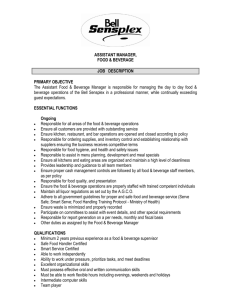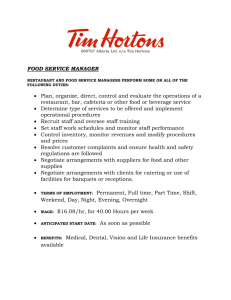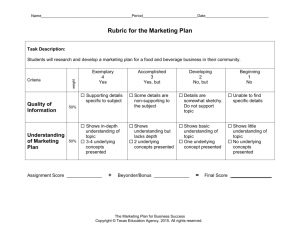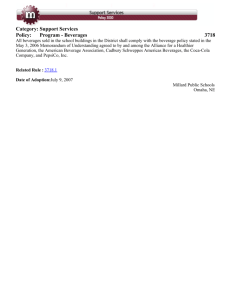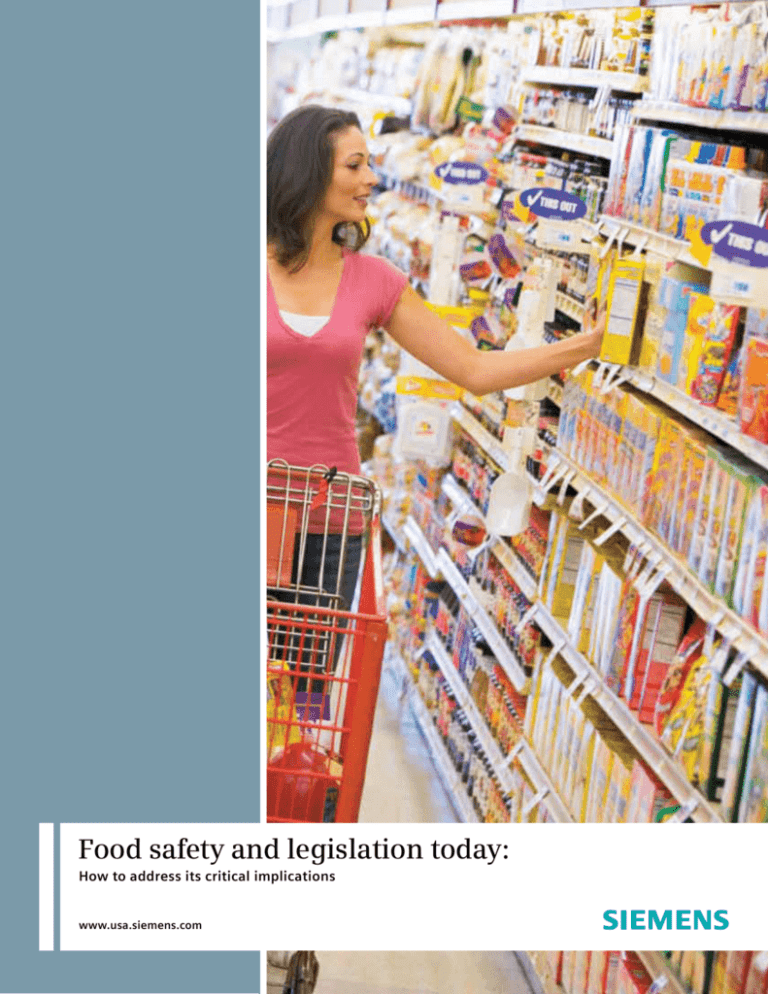
Food safety and legislation today:
How to address its critical implications
www.usa.siemens.com
Wary consumers, concerned legislators,
uncertain producers
The call, text or email could come any time of day or
night, weekends or holidays too: “We’ve got a problem.”
For food and beverage producers, among the worst
possible news would be that products, already in stores,
are contaminated serious enough to have caused
consumers illness, hospitalization or, most terrible of
all, death.
According to the U.S. Centers for Disease Controls,
each year approximately 76 million Americans – about
25 percent of the total population – get sick from
contaminated food or drinks, resulting in some 300,000
hospitalizations and 5,000 deaths. As the chart to the
right shows, the trend in food and beverage recalls is
not encouraging: From 2006 to 2008, the number has
more than doubled.1
Hard facts like these are why consumers have more
concerns with food and beverage safety, concerns
that are fanned by national recalls that seem to
be increasing. Not surprisingly, these recalls are
undermining consumer trust – a key brand attribute
for food and beverages – and now, at a time when more
than ever, that trust is built on food safety.
1
Food Industry Report, August 2009
Short and long-term business impacts.
Financial concerns about food and
beverage safety haunt producers, too. On
average, recalls cost $10 million – monies
that come straight from the bottom line.
That’s just the average; some recalls have
hit producers much harder, up to $100
million or more. Adding to those huge
sums are hidden post-recall costs for such
things as:
•
•
•
•
•
•
•
•
•
Lost brand equity
Investigations
Inventory losses
Product removal
Product destruction
Legal fees
Product replacement
Loss of sales
Brand “re-marketing”
When a recall does occur, time is critical as
each passing day can lead to more illness
among consumers, while devastating
a company’s market capitalization and
ruining its brand image.
For example, one day after a recall
announcement, producers experience an
average 2.3 percent drop in share price
compared to their sector index. Worse,
if a recall is handled poorly, a producer’s
share price drops on average 22 percent
compared to its sector index just two
weeks after a recall announcement.2
Brand loyalty and even a product
category preference can evaporate just as
quickly. The 2010 spinach recall stopped
consumers from not just buying the brands
being recalled but all spinach – with five
percent of consumers surveyed saying
they would never buy spinach again.3
Many reported that they stopped buying
bagged salad items altogether, despite the
convenience bagging can provide.4
A walk down the food and beverage
aisles in today’s supermarket is a walk
through long-term treasure trove of
brand investments in advertising, shelfplacements, couponing, and the like worth
2
3
4
hundreds of millions, if not billions, of
dollars. Should a recall strike any one of
those products, not only will it be pulled
from its shelves (and possibly replaced with
a competitor) but all its brand investment
is also at risk, if not completely ruined
depending on how serious the recall.
Worse, if the product is part of a larger
brand portfolio, its recall can also taint
consumer trust in other members of the
brand family.
and beverages for the sake of profit and
notoriety, respectively.
Today more than ever, product success is
built not just on brand quality but food
safety, too.
What’s more, whenever they change any
part of their production process – adding
a new ingredient supplier, opening a new
process line, rearranging a cooler or any
other changes – they need to reassess
their food safety risk profile. Obviously
changes can introduce new hazards and
those hazards need to be identified and
addressed. Food safety is not static; it’s a
matter of continuous improvement.
The uncertain path forward.
Given the growing number of recalls,
it’s a small wonder that the polls have
shown nearly 90 percent of voters support
stricter food safety regulation. And state
and federal legislators are responding.
Most notable are two bipartisan pieces of
landmark federal legislation – H.R.2749,
the Food Safety Enhancement Act,
and S.510, the U.S. Food and Drug
Administration (FDA) Food Safety
Modernization Act. While these seem
certain to become law, it’s uncertain when
and, until then, they have cast tremendous
uncertainty over the food and beverage
industry about how to proceed with
investments in product safety.
To be sure, food and beverage producers
share the public’s concern for a healthy
food supply. Industry associations have
long recognized a shared responsibility for
the healthy hygiene of the farm-to-fork
supply chain, working with regulators to
ensure the safety of its throughput. After
all, they and their families are ultimately
food consumers, too.
A core challenge, however, is the growing
complexities of that supply chain. Some
drivers of those complexities include the
globalization of the food supply, exploding
numbers of in-store SKUs, error-prone
(and unscalable) human processes, and
counterfeiters and malcontents intent
on compromising the safety of food
Collaborative Approaches to Improving Consumer Safety and Confidence, 2010
DailyFinance.com, August 2010
Food Institute Policy Report, 2007
Practical, proactive risk management.
Of course, to protect consumers as well
as their own brands and businesses, food
and beverage producers can never be too
vigilant about the quality and provenance
of their ingredients, the cleanliness of
their operations or the sanitation of their
distribution channels.
But all that is a lot to track. And playing
the odds of not breaking a critical control
point (CCP) sometime or somewhere along
the supply chain are odds best left in Las
Vegas.
The most practical, proactive approach
to managing this risk is the systemic use
of real-time and historical data to derive
informational insights and avert trouble
before it happens. Then, should a problem
occur, even a recall, response times can be
much faster, helping to contain the harm
to customers, the business and the brand.
Better yet, producers can use this data
to help them build their brands through
greater value, superiority, consistency and,
as mentioned, safety.
With new federal legislation likely, food and
beverage producers may face uncertainties
about its implementation and timing.
However, out of all the key legislation
components, they can take steps today to
meet four certain implications of the draft
legislation: Food Defense; HACCP; RecordKeeping & Reporting; and Traceability &
Genealogy.
3
Food Defense
Food and beverage producers can do a lot
to ensure food safety by addressing the
sources of accidental contamination by
biological, chemical and physical hazards.
However, their efforts cannot stop there.
They also must take action to prevent
intentional contamination by people intent
on doing harm. These people can be
intruders or insiders, such as disgruntled
current or former employees who may
know facility security controls and how to
bypass them.
1. Perform a Food Defense Assessment:
An individual or team should be put in
charge of this assessment, which takes a
critical look at security around the
property perimeter – gates, locks, access
control, lighting, human or video
surveillance and the like -- then similarly
evaluates the exterior and interiors of all
buildings on the property. It also
considers who has authorized access to
what parts of the plant and if existing
restrictions are sufficient protection.
In short, preventing the intentional harm of
food by others is called “food defense.” Such
measures not only can protect ingredients,
work-in-progress and inventories of finished
goods but they can also help to improve the
safety of other employees and other plant
assets. Ultimately, like food safety vigilance
and systems, food defense can help protect
the well-being of a food or beverage
producer’s business.
2. Build a Food Defense Plan:
After performing an assessment, any
security vulnerabilities should be
identified. A clear set of measures to
address those risks should be drawn up,
with a budget and timeline for their
implementation. For example, if food
storage areas are open to all, some form
of access control should be put in place.
It could be as simple as a lock-and-key
system, with a paper log of who checked
out the keys and when, or it could be a
more sophisticated electronic access
control system with badge entry that
automatically logs who is coming and
going from food storage areas.
Prudence and good business practices
suggest writing a Food Defense Plan. The
plan will identify all the gaps in facility and
food security that might exist both inside
and outside a plant, including storage and
shipping and receiving – general points of
vulnerability.
A straightforward and effective approach to
developing a Food Defense Plan takes three
steps:
4
3. Implement the Food Defense Plan:
Based on the budget and timeline of the
Food Defense Plan, the necessary steps
to close the gaps need to be taken with
oversight by the person or team in
charge of the plan. In case of a crisis, the
plan should be enhanced with
contingent operational specifics such as
internal and external contact lists, an
issue escalation protocol and staff
training in the plan itself and any new
procedures required. It should include
dates for periodic reviews of the plan (at
least annually) and any needed revisions
to reflect plant changes or newly
discovered vulnerabilities. Also
suggested is a “tabletop” exercise of the
key personnel who would be involved in
a Food Defense crisis, based on a
prescribed scenario with the team
responding according to the protocol(s)
outlined in the plan. This is valuable
before a crisis because it helps familiarize
the key players with those protocols and
it tests the steps in those protocols
against the scenario.
With a Food Defense Plan implemented and
complemented by a comprehensive food
safety program, producers can be confident
that they have done all they can to protect
their end-use customers, their channel
partners and their own brands and
businesses from harm – or, if somehow
these protections are violated, they know
that they will be able to contain the harm
as much as possible.
Hazard Analysis Critical Control Point (HACCP)
Before the widespread adoption of HACCP
by the food and beverage industry, food
safety relied on spot-checks of production
environments and random samplings of
final products. The drawback of this
approach, however, was it being inherently
reactive instead of proactive.
TIA is a comprehensive process control
system (PCS) that includes both the
necessary process line controller (PLC) and
the human machine interface (HMI). It can
help optimize the overall performance of
food and beverage production facilities
while helping to address health threats by
monitoring CCPs in their processes.
HACCP, in contrast, is a systematic,
preventive approach to food and beverage
safety. It originated in the 1960s to help the
U.S. National Aeronautics and Space
Administration (NASA) develop safe foods
for space flights. In the following decades,
HACCP was increasingly recognized
worldwide as the basis of a logical, sciencebased food safety system.
An MES can complement TIA’s “watch” on
production by linking food and beverage
plant processes with Enterprise Resource
Planning (ERP) systems like SAP, Oracle and
others. An MES can capture hundreds of
CCP data points every minute and display
key indicators in full-color graphs, charts
and dashboards.
Today, the U.S. government mandates its
use by the meat, seafood and juice
producers, and other food and beverage
producers are using it voluntarily. The
International Organization for
Standardization (ISO) also incorporated
HACCP’s principles into its comprehensive
food safety standard ISO 22000.
In its role as an interface between realworld automation systems and upper level
planning and financial systems, the MES
layer provides production monitoring and
modeling. It can also provide a view into
Overall Equipment Effectiveness (OEE) as
well as downtime monitoring and inventory
control.
A CCP is any step in a food and beverage
production process where a control can be
applied to prevent, eliminate or reduce food
safety hazards to acceptable levels.
With an electronic-based HACCP system in
place, food and beverage plant operators
can gain tremendous production precision,
flexibility and efficiencies. In addition, and
critical to ensuring food safety, they can
also realize greater operating transparency
across their production lines, less time in
discovering deviations and taking corrective
actions, and greater confidence in the
safety of their products. All of this can help
to dramatically reduce compliance costs,
too.
While CCPs can be applied and monitored
manually, large-scale production plants
make it impractical to do so because there
may be hundreds of CCPs and the effort
and potential for human error is huge. This
has driven the development of advanced
applications of information technology such
as Totally Integrated Automation (TIA) and
Manufacturing Execution Systems (MES)
that can provide an electronic HACCP
system – or “e-HACCP” if you will.
HACCP’s seven principles
1. Conduct a hazard analysis. Determine
all possible food safety hazards and
identify what can prevent these
hazards. A food safety hazard is
anything that may cause a food to be
unsafe for human consumption.
2. Identify critical control points (CCPs).
Identify those steps in food and
beverage production where controls
can apply and help prevent, eliminate
or reduce hazards to acceptable levels.
3. Establish critical limits for each critical
control point. Critical limits set
maximum or minimum values to
which food safety hazard must be
controlled at a CCP.
4. Establish critical control point
monitoring requirements. Monitoring
helps ensure a process is under
control at each CCP.
5. Establish corrective actions. When
monitoring indicates deviations from
established critical limits, corrective
actions bring the CCP back within
those limits and that no output enters
the food chain because of the
deviation.
6. Establish record-keeping procedures.
These document a plant’s monitoring
of critical control points, critical limits,
verification activities and how
deviations are handled.
7. Validate that the HACCP system works
as planned. This ensures that plants
operate as designed to ensure safe
products.
5
Recordkeeping & Reporting
The data produced by manually monitoring
a food or beverage plant’s quality from just
periodic spot-checks can create a nightmare
of paperwork, not to mention the potential
for errors and omissions. Even with
automation, the flood of real-time data
from 24x7 monitoring can pose challenges
of data storage, backup, mining, reporting
and analysis. Simply put, having a lot of
data isn’t useful if it’s not accessible.
Of course, the sooner a CCP violation is
known, the sooner it can be corrected and
the less production is wasted, not to
mention the vastly reduced chances of any
contaminated output making its way into
the food supply. Even better, to avoid CCP
violations altogether, statistical process
control (SPC) can issue advisory alarms
when a process starts to destabilize but
before it exceeds a CCP limit.
Data accessibility is critically important to
optimize production processes for
maximum efficiency and output. Food and
beverage production managers face issues
enough each day having to constantly tame
a wide range of variables associated with
source inputs and the production
environment (e.g., temperature, humidity,
production timing, channel and market
demands among them). They should at
least be able to be assured that their CCPs
are operating within set parameters and, if
not, that they’ll be alerted so they can take
fast corrective actions.
TIA and MES systems can also tie into a
laboratory information management system
(LIMS) module, seamlessly integrating
automatic sample testing with the plant’s
production and quality management
systems. A LIMS can be used to sample raw
material, work-in-progress or final products,
ensuring their specification conformance. If
not, plant management can be alerted
before production runs are expensively
compromised or final products enter the
food chain.
Faster access, faster response.
For example, via CCP sensors specified by
the quality control design of a process, a TIA
system coupled with an MES can gather and
log production data in real-time. Collecting
data this way eliminates the labor, latency
and mistakes of doing so manually. Realtime CCP data also can trigger alarms as
soon as a parameter is violated, initiating
automatic responses based on preset rules.
If human intervention is needed, the system
can alert the right person.
6
Better quality control and compliance
reporting.
Another reason for rapid data accessibility is
to improve quality management and
compliance reporting. Although more and
more food and beverage producers are
making regulatory compliance a normal
business practice, they face a delicate
balancing act: Reconciling quality and
regulatory compliance requirements with
their needs for efficiency, productivity and
flexibility to meet profitability and market
demands.
TIA coupled with an MES can help
producers strike the right balance in a much
more precise and data-driven way. Together
these systems can help producers tie their
process control into their business systems
while synchronizing their operations along
the entire production life cycle. This can
offer them a detailed and more nuanced
view of their entire manufacturing and
supply chain, both in real-time for
optimizing operations and quality and
historically for trend analysis.
Data associated with alarms, for example,
can be logged for corrective action to
document a plant’s response to process
failures and help drive continuous
improvement efforts. When CCP limits
destabilize or breach limits, analytics can
help derive operational and process insights
to quickly identify and eliminate the
problem’s root causes. Paper-based systems
can require days or weeks – and offer
nothing close to the analytical power of an
automated approach that may take mere
minutes or hours.
To meet regulatory, customer and internal
audit requirements, TIA and MES systems
can generate needed HACCP reports almost
instantly from the plant database. This
eliminates the cost and trouble of storing
paper records not to mention the time
required to get the records and rebuild a
production history from them.
Traceability & Genealogy
Food traceability and genealogy capabilities
are vital to the public’s health as well as
that of the food industry. Typically when a
large-scale, food- or beverage-borne illness
breaks out in the public arena, regulators
and producers rush to find the cause to
prevent additional cases from occurring.
But days can pass and confusion can mount
about the source or sources of
contamination, given our food supply
chain’s enormous complexities.
In that time, despite a regional or
nationwide recall, people can keep falling
ill. An entire food category can suffer,
sometimes unjustifiably so, like the
salmonella breakout in 2008 that was
initially blamed on tomatoes. Although
jalapeno peppers eventually were at fault,
average tomato prices dropped about 50
percent with a total industry cost estimated
at $100 million.
Product traceability within the food and
beverage supply chain documents where
intermediate and final products are, where
they are going and where they came from.
An important capability of a traceability
system is handling recalls quickly and
efficiently, to limit the spread of illness and
damage to customers’ confidence and trust
to a producer’s brand.
At the same time, producers need to
respond to increasing market demands for
5
more products, for shorter time-to-market
and for multi-site production, all of which
requires them to create strict production
protocols that always ensure high quality
output.
It’s important to note that traceability is a
plant issue and not a business one. That’s
because it’s only at the plant level that you
can achieve the right visibility of the
individual product lots and their process
CCPs. Plant IT infrastructure must support
continuous integration of production
operations and shop-floor activities to
effectively monitor where and when
ingredients and intermediate products are
moved and transformed or where and when
final products are stored or shipped.
TIA and an MES can build comprehensive
product genealogies by recording data on
any inbound ingredient such as ID number,
incoming date and time, its supplier’s
delivery information and so forth. The
systems then can record every step of those
ingredients’ processing along the entire
manufacturing lifecycle. This includes their
transformation into intermediate materials
and where they flow through the plant. In
case of contamination, finding out where
and when products were processed, moved
and stored during production becomes
quick and easy, thanks to a complete
genealogical history of a product.
Process genealogy supports traceability by
providing two key functions: One is called
“genealogy execution,” which builds a
record of the myriad production steps taken
inside a plant; the other is called “genealogy
analysis,” which provides the means to
display upstream or downstream
information from any point within the plant
or, given extended interoperability with the
systems of suppliers and channel
customers, within the supply chain. If a
recall is needed, every ingredient can be
traced for every product. If done soon
enough, product lots can be recalled before
their goods reach a store, saving customers
from possible illness and saving producers
expense and brand damage.
Fresh Tomato Industry Shaken by FDA Salmonella Link, Seeks Answers,” by Cary Blake, Western Farm Press, Aug. 21, 2008
7
Making the business case for addressing these
issues now
Given the critical importance of food safety
and food defense to producers, both need
to be viewed not as expenses but as an
important capital investment in the future
of their businesses while providing risk
management. The same return on
investment (ROI) criteria should be used,
just as if a new production line or packaging
machine are being considered.
Take, for example, the fact that an average
recall costs $10 million, not counting
hidden contingent costs. For a producer
with $100 million in annual sales and 10
percent net margins, a recall’s cost of that
8
size would wipe out bottom line profit for
the year. If a high-quality food safety and
defense program, with the former based on
TIA coupled with an MES, would require up
to a million dollars in startup capital
investment, amortized over 10 years, that’s
$100,000 a year.
Add to that a 15 percent operating cost of
$150,000 a year, the total annual
investment in comprehensive food safety
and defense protections would be
$250,000 or about 0.25 percent of annual
revenue, which would seem a reasonable
investment in protecting annual profits and
brand equity, which in quantified terms,
would be the sum to-date of all investments
in promotion and distribution during the life
of the product.
Notably, this investment calculation only
takes into consideration the cost avoidance
of a recall and does not include other
quantifiable benefits from a TIA/MES
combination such as greater operating
precision, production line flexibility and
product throughput, while realizing labor
savings through automation.
Conclusion
Many food and beverage producers have
already embarked on the path to TIA and
MES in their production facilities, taking
steps to integrate these systems into their
quality and process architectures. They also
realize that actionable information can be
used to both build and protect brand value.
However, many “homegrown” legacy
systems may still be in place, either manual,
paper-based systems, proprietary, closedended electronic systems or some
combination of the two.
With stricter federal and state food safety
legislation almost certain, it’s
understandable if not ironic that this
certainty has produced extreme uncertainty
in what kinds of investments will be needed
when. The resulting “wait-and-see”
approach could be inaction. However,
inaction can have hazards all its own,
especially complacency.
While food and beverage producers are
watching legislative developments very
closely, they should also take the time
before any legislation becomes law to fully
evaluate their current food safety and
defense infrastructure and programs. They
should do this not only in light of new
regulatory implications but also in the
context of how TIA and MES can help them
improve their overall business efficiency
and performance, while reducing their
recall risk profile and protect the value of
their brand.
9
How Siemens technology can help protect
your brand
Siemens has served the worldwide food and
beverage manufacturers since dawn of
automation. We have developed a wealth of
best-practice knowledge and applied
expertise, plus an engineering staff with
hundreds of years of combined experience.
We offer a portfolio of proven, advanced
solutions to optimize your food and
beverage plant operations so you can
maximize your company’s profitability and
market share. With a deep understanding of
the dynamic and highly competitive
markets food and beverage producers
address, Siemens stands ready to help you
achieve your highest production goals and
increase the value of your enterprise for all
of your stakeholders. www.usa.siemens.com/foodbev
10
nSIMATIC PCS7 provides food and
beverage producers with Totally
Integrated Automation (TIA). It enables
full integration of all plant automation
systems including process, batch,
discrete and safety and all field devices.
More than 6,000 installations worldwide
make it a proven TIA platform.
It also integrates instrumentation,
analytics, motors, drives and safety
devices, with tools for engineering,
visualization and facility-wide asset and
maintenance management. It can
provide for automatic scheduling,
coordinating and controlling food and
beverage product flows as well as
cleaning-in-place (CIP) operations across
an entire plant, small or large.
SIMATIC PCS7 is more than just a
process line controller (PLC) and human
machine interface (HMI). It offers a
comprehensive library of pre-built and
pre-configured generic and food and
beverage-specific functions in discrete
software modules based on bestpractices from around the world, across
automated industries and from within
the food and beverage industries.
nSIMATIC IT Manufacturing Execution
System (MES) connects existing
automation “islands” across a plant as
well as enables manual processes to be
automated and incorporated into a
plant-wide MES. Like the SIMATIC PCS7,
this MES offers a library of pre-built and
pre-configured generic and industryspecific functions. Based on a modular,
object-oriented, open and scalable
architecture, the SIMATIC IT MES offers
both horizontal integration and vertical
integration of plant floor control layers
into higher-level systems such as the
plant’s ERP system. It uses the ISA-95
standard as its architectural blueprint.
nSIMOTION Motion Controllers
integrate drive control and machine
automation into one platform for
handling complex hydraulic,
pneumatic, vector or servo motion
tasks.
nComponent-based Automation is the
key to enabling the Optimized
Packaging Line. CbA provides a
standard interface for each machine,
which dramatically decreases
engineering and commissioning times
while providing enhanced diagnostics
and troubleshooting.
nSIMATIC HMI are advanced operator
panels that provide remote monitoring
and control of each machine of an
Optimized Packaging Line (OPL) as well
as remote web based access to
monitor real-time status.
nSupport & Training – Live, U.S.-based
technical support is available free
during normal business hours.
Advanced web-based support and
24x7 technical support are also
available without the need for support
contracts. In addition, Siemens also
has a network of Authorized Solution
Partners, each which understand
Siemens technology and solutions and
can apply them to your enterprise.
nContact: Walter Staehle
VP Food & Beverage
Director VMM
+1 (215) 646 7400 x2522
walter.staehle@siemens.com
Totally Integrated Automation
11
Siemens Industry, Inc.
Industry Automation
3333 Old Milton Parkway
Alpharetta, GA 30005
1-800-241-4453
info.us@siemens.com
www.usa.siemens.com
Subject to change without prior notice
Order No.: FBBR-FSVMM-1110
All rights reserved
Printed in USA
©2010 Siemens Industry, Inc.
The information provided in this brochure contains merely
general descriptions or characteristics of performance
which in case of actual use do not always apply as described
or which may change as a result of further development
of the products. An obligation to provide the respective
characteristics shall only exist if expressly agreed in the
terms of contract.
All product designations may be trademarks or product
names of Siemens AG or supplier companies whose use by
third parties for their own purposes could violate the rights
of the owners.

